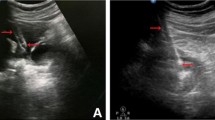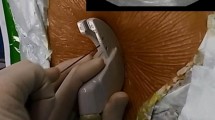Abstract
The objective of the study was to evaluate the feasibility and safety of balloon dilation for ‘X-ray’-free ultrasound-guided percutaneous nephrolithotomy (PCNL). From January 2012 to December 2012, patients underwent ‘X-ray’-free ultrasound-guided PCNL with Amplatz dilator (Group A). From January 2013 to April 2014, patients underwent ‘X-ray’-free ultrasound-guided PCNL with balloon dilator (Group B). For balloon dilation, a 10F fascial dilator was used to dilate the tract. Subsequently, the 6F nephrostomy balloon (8 mm in diameter) was indwelled along the guidewire with a marked length equal to the dilation depth. Under the monitoring of ultrasound, the location of balloon was secured and disappearance of balloon waist was confirmed when the balloon was inflated at a pressure of 20 atm. A total of 163 patients were involved in this study. Of 81 procedures in Group A, 45 procedures were performed by a senior urologist while 36 procedures by a resident. Of 82 patients in Group B, 47 procedures were performed by the same senior urologist while 35 procedures by another resident. For the senior urologist, there was no statistically significant difference between two groups in calyx of entry, stone-free rate, decline of hemoglobin and hematocrit, operation time and hospitalization. But for the residents, there was less decline of hemoglobin and hematocrit, tract development time and hospitalization in Group B compared to Group A (0.6 vs. 1.7 g/dl, p = 0.001; 2.3% vs. 5.5%, p = 0.003; 10.1 vs. 11.0 min, p = 0.027; 7.8 vs. 13.9 days, p < 0.001). Balloon dilation method introduced in this study is compensable for tract development when ‘X-ray’-free ultrasound-guided PCNL is performed. Modified techniques make totally ultrasound guidance for PCNL feasible, easy and safe. In addition, such a procedure is preferable for initial operators because of less hemorrhage complication.




Similar content being viewed by others
References
Wong MY (2001) An update on percutaneous nephrolithotomy in the management of urinary calculi. Curr Opin Urol 11:367–372
Preminger GM, Assimos DG, Lingeman JE, Nakada SY, Pearle MS, Wolf JS Jr (2005) Chapter 1: AUA guideline on management of staghorn calculi: diagnosis and treatment recommendations. J Urol 173:1991–2000
Frattini A, Barbieri A, Salsi P, Sebastio N, Ferretti S, Bergamaschi E et al (2001) One shot: a novel method to dilate the nephrostomy access for percutaneous lithotripsy. J Endourol 15:919–923
Gamal WM, Hussein M, Aldahshoury M, Hammady A, Osman M, Moursy E et al (2011) Solo ultrasonography-guided percutaneous nephrolithotomy for single stone pelvis. J Endourol 25:593–596
Falahatkar S, Neiroomand H, Enshaei A, Kazemzadeh M, Allahkhah A, Jalili MF (2010) Totally ultrasound versus fluoroscopically guided complete supine percutaneous nephrolithotripsy: a first report. J Endourol 24:1421–1426
Karami H, Rezaei A, Mohammadhosseini M, Javanmard B, Mazloomfard M, Lotfi B (2010) Ultrasonography-guided percutaneous nephrolithotomy in the flank position versus fluoroscopy-guided percutaneous nephrolithotomy in the prone position: a comparative study. J Endourol 24:1357–1361
Yan S, Xiang F, Yongsheng S (2013) Percutaneous nephrolithotomy guided solely by ultrasonography: a 5-year study of >700 cases. BJU Int 112:965–971
Lee SM, King J, Spargo BH (1991) Efficacy of percutaneous renal biopsy in obese patients under computerized tomographic guidance. Clin Nephrol 35:123–129
Hosseini MM, Hassanpour A, Farzan R, Yousefi A, Afrasiabi MA (2009) Ultrasonography-guided percutaneous nephrolithotomy. J Endourol 23:603–607
Dehong C, Liangren L, Huawei L, Qiang W (2013) A comparison among four tract dilation methods of percutaneous nephrolithotomy: a systematic review and meta-analysis. Urolithiasis 41:523–530
Benway BM, Nakada SY (2008) Balloon dilation of nephrostomy tracts. J Endourol 22:1875–1876
Tomaszewski JJ, Smaldone MC, Schuster T, Jackman SV, Averch TD (2010) Factors affecting blood loss during percutaneous nephrolithotomy using balloon dilation in a large contemporary series. J Endourol 24:207–211
Wezel F, Mamoulakis C, Rioja J, Michel MS, de la Rosette J, Alken P (2009) Two contemporary series of percutaneous tract dilation for percutaneous nephrolithotomy. J Endourol 23:1655–1661
Lopes T, Sangam K, Alken P, Barroilhet BS, Saussine C, Shi L, de la Rosette J, Clinical Research Office of The Endourological Society Percutaneous Nephrolithotomy Study Group (2011) The Clinical Research Office of the Endourological Society Percutaneous Nephrolithotomy Global Study: tract dilation comparisons in 5537 patients. J Endourol 25:755–762
Conflict of interest
The authors declare that they have no conflict of interest.
Author information
Authors and Affiliations
Corresponding authors
Additional information
T. Zhou, G. Chen and X. Gao contributed equally to this work.
Rights and permissions
About this article
Cite this article
Zhou, T., Chen, G., Gao, X. et al. ‘X-ray’-free balloon dilation for totally ultrasound-guided percutaneous nephrolithotomy. Urolithiasis 43, 189–195 (2015). https://doi.org/10.1007/s00240-015-0755-7
Received:
Accepted:
Published:
Issue Date:
DOI: https://doi.org/10.1007/s00240-015-0755-7




